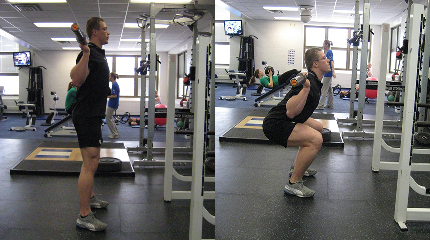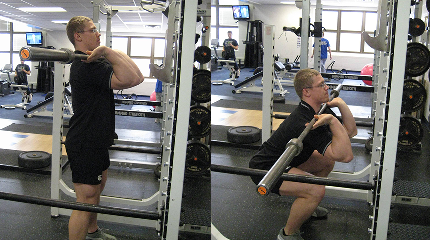Excellent(!!!)
Thanks.
Is Back Squat Better Than Front Squat?
March 31 2009
Which is better: Back squat or front squat? Back squat is one of those exercises which has a bad ass reputation of being THE best for overall muscle growth in your legs.

On the other hand, front squat is often sidelined as one of those secondary exercises to isolate or emphasize the quads . Or it is considered to be more more of a shaping exercise.

To see if there is any truth to these long-held beliefs, a recent study compared the back squat to the front squat in men and women who were experienced at doing both the lifts.
The study used 70% of their 1RM (maximum weight that can be lifted for one rep) for both the exercises thereby ensuring that they are comparing exercises of similar intensity.
Results
- Though the back squat used a heavier weight, muscle activity recorded in quads, hamstrings and low back was similar in both exercises. In other words, both exercises theortically are equally effective in making your legs grow!
- Compressive forces were much lower in front squats than back squats. High and continued compressive forces on the knee can cause loss of cartilage and result in osteoarthritis (usually pain in the knees).
- Glute activity was not measured in the study.
Conclusion
Front squat is equally good as back squat for your quads and hams from EMG results. As well, front squat is lot better on your knees than back squat.
If knee health & muscle activation is a concern, you might want try front squats for a change.
Related
Related Articles
Anoop,
Thanks for researching and writing this. It seams like the King of lower body exercises may be in jeopardy of losing his crown. My knees have experienced the benefits of the front squat and now I know my thighs are as well.
Anoop | Wed April 01, 2009
Thanks guys
I am surprised that they didn’t look at glute activity.The study was done at Univ of Florida. If it was a couple of years back, I would have walked in to Dr. Tillman’s office and asked him.The biomechanics lab was in the same lab as the muscle physiology lab and I used to see him all the time.
The greatest activity in the muscle groups was seen in the semitendinosus muscle and the least in biceps femoris. Every muscle showed greater activity wth squats but didn’t reach significance.
Anoop | Thu April 09, 2009
If you look at the results, you notice that the hamstrings shows more activation than the quads which is not the same in other squat studies.
This is due to the technique involved. Greater trunk lean means more hip extension, and thus more activation of the hamstrings.
great to see that you are back to writing again - last i had seen your work was at avantlabs…to front squat heavy weights with the kind of forward lean that is pictured is very very difficult - if not impossible. although i prefer the front squat myself since it find it easier to do; the trunk angle on the back squat facilitates a much better overall recruitment of the posterior chain - this of course is anecdotal but i feel a lot of lifters would agree with this. does the study tell us the loads used? - if the trainees were using the same weight on both exercises then i see how the results would show similar effects. however, most people can lift at least 30% more weight on the back squat - that alone makes it the more effective exercise. and again - did they use high bar olympic style back squats as displayed in the picture? this has a much more similar recruitment pattern to the front squat than a powerlifting style back squat.
Anoop | Sun April 19, 2009
Hi rg,
Thanks for posting. This is my website so you will see a lot of writing by me here.
The truck lean indeed affects the recruitment. The post just before yours by me talks about the exact same thing.
The weights used in both lifts are normalized. That means you take the 1RM on each each exercise and then find the 8 or 10RM. This way you are comparing just the exercise at the same intensity. It’s a standard procedure when you are doing strength studies.
And did you read the article, rg? If you did , you wouldn’t have missed these:
“The study used 70% of their 1RM (maximum weight that can be lifted for one rep) for both the exercises thereby ensuring that they are comparing exercises of similar intensity.”
“Though the back squat used a heavier weight, muscle activity recorded in quads, hamstrings and low back was similar in both exercises. In other words, both exercises are equally effective in making your legs grow!”
Almost all squat studies used a bar position which is neither high bar or low bar as in powerlifting. That is, they used a generic bar position.
And how did you find the site, rg?
Hello Anoop,
I saw the link on somasimple.com’s boards. I did not read the article carefully - oops. But how can I get access to the entire study? The link shows just an abstract. Also did they talk about the compressive and shear forces on the spine of each exercise?
Anoop | Sun April 19, 2009
I am a member of the National Strength & Conditioning Association (NSCA). So I get their journals every month.
I tried to log in and access the journal online, but for some reason I cannot.
No,they didn’t measure the forces at the spine. Excessive lumbar extension has shown to increase compressive forces ta the spine. Neutral spine is best to minimize compressive forces.
pattybirk | Fri September 04, 2009
What about the wrist issues with the front squat (as in the pic above)? Looks harsh!
unless you have incredibly stiff wrists your wrists will adapt- you can also try the crossed arm approach although i find that a less stable and more awkward position
Anoop | Sat September 05, 2009
Hi Patty,
Part of the harsh look is because of the pic. It is a bit stretched out as you can tell which makes it look like he leaning too forward or his wrists are too far extended. I ad to minimize it a bit to get 2 pics in that square.
And as rg rightly says wrist probelms with front squats are a flexibility issue than anything else.
And the grip is supposed to be “closed” not open as shown, but I missed it somehow. When you do crossed , the grip is open though.

